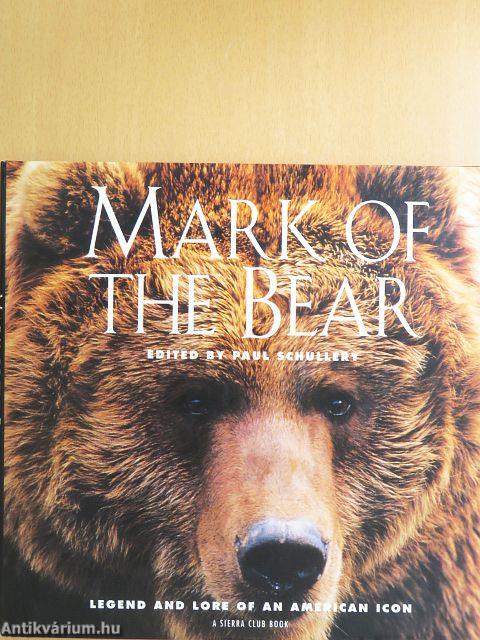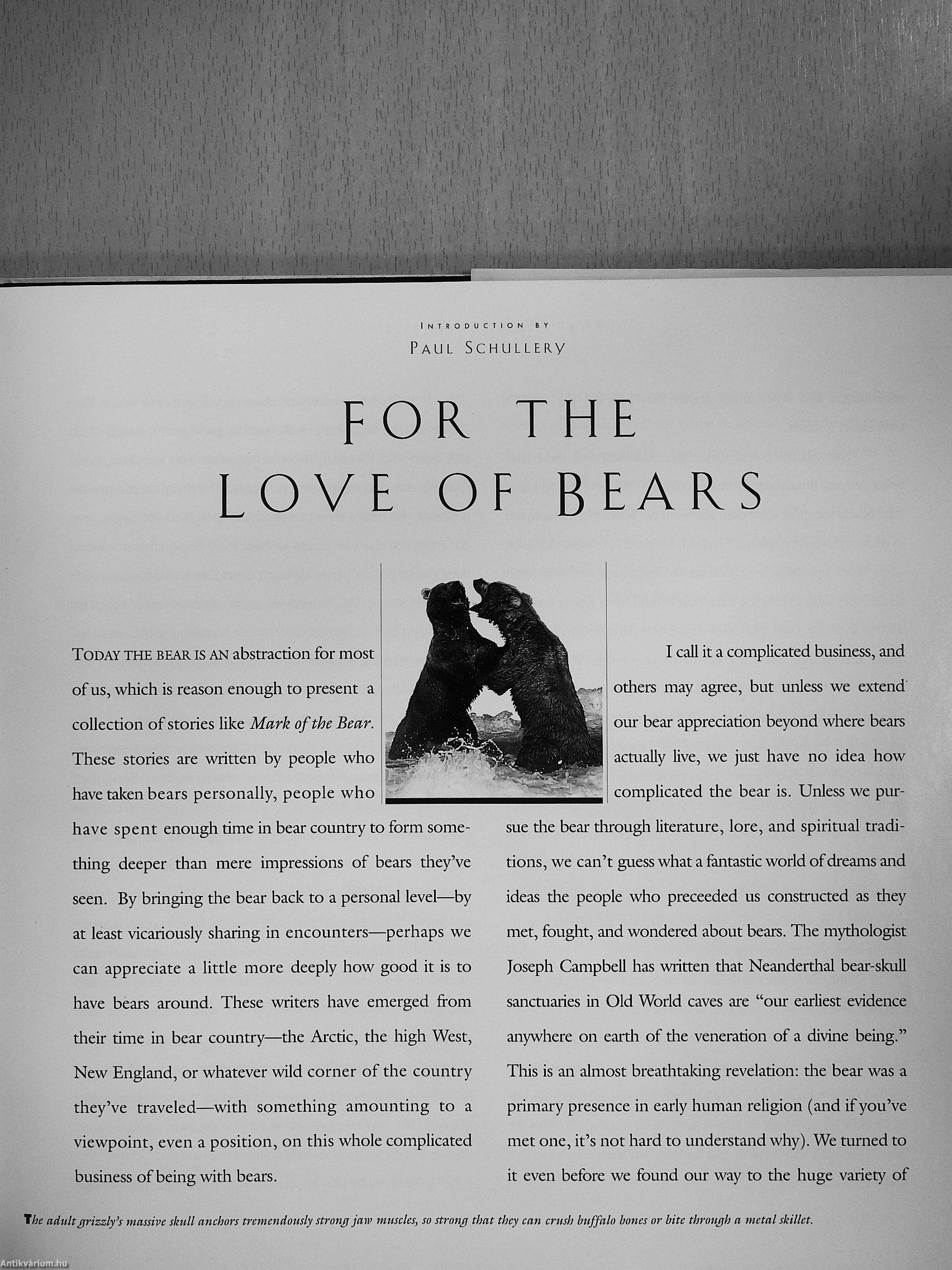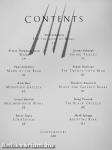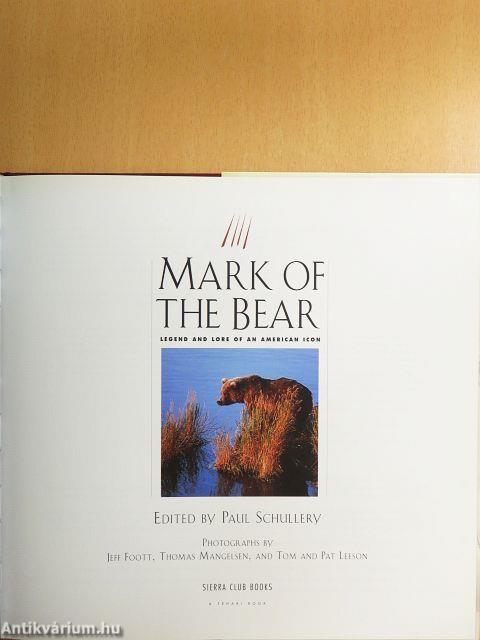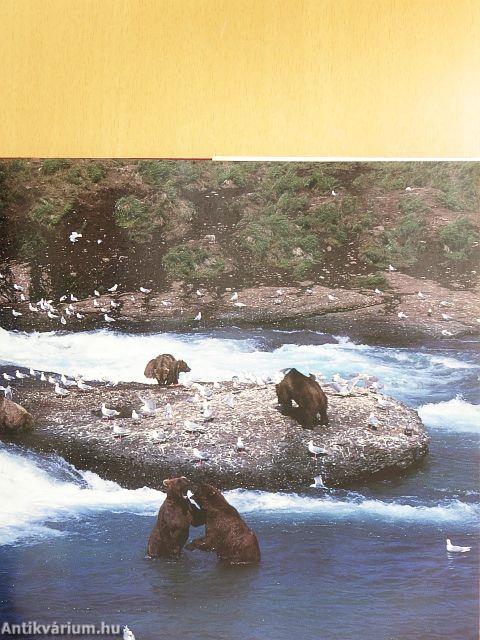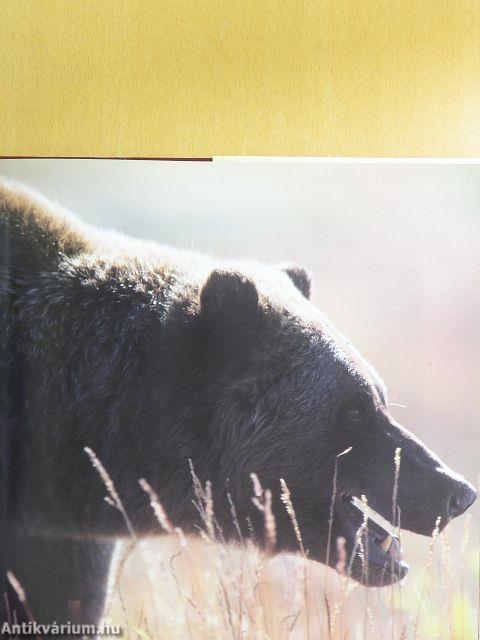1.067.073
kiadvánnyal nyújtjuk Magyarország legnagyobb antikvár könyv-kínálatát

VISSZA
A TETEJÉRE
JAVASLATOKÉszre-
vételek
Mark of the Bear
Legend and Lore of an American Icon
| Kiadó: | Sierra Club Books |
|---|---|
| Kiadás helye: | San Francisco |
| Kiadás éve: | |
| Kötés típusa: | Vászon |
| Oldalszám: | 120 oldal |
| Sorozatcím: | Tehabi Books |
| Kötetszám: | |
| Nyelv: | Angol |
| Méret: | 25 cm x 26 cm |
| ISBN: | 0-87156-903-5 |
| Megjegyzés: | További kapcsolódó személyek a könyvben. Színes fotókkal. |
naponta értesítjük a beérkező friss
kiadványokról
naponta értesítjük a beérkező friss
kiadványokról
Előszó
TovábbFülszöveg
MARK OF THE BEAR
LEGEND AMD LORE OF AM AMERICAN ICON
The tracks disappeared as the bear walked out of the thin snow, as the new snow disappeared into open patches of sun. I thought of how the mild sun mustfed on his thick coat I thought of the sweeping length of his claws. How can the world still have such a wondrous beast in it—just on the edge of surviving, but still here?—rick bass
Powerful, fierce, and magnificent, the Bear is the subject of myths and legends—an animal that strikes in us a sense of fear, caution and curiosity. Portrayed in folldore and fiction as naive yet intelligent, forgiving yet vicious, the Bear transcends all that divides man and animal, suggesting how alike we are, yet how fascinatingly different.
If we are lucky, we see the Bear through its teU-tale signs—a claw-scarred tree, the buried carcass of an elk or deer, or the chewed remains of a salmon left along a mountain stream. But we come to Icnow the Bear through those who have encountered them,... Tovább
Fülszöveg
MARK OF THE BEAR
LEGEND AMD LORE OF AM AMERICAN ICON
The tracks disappeared as the bear walked out of the thin snow, as the new snow disappeared into open patches of sun. I thought of how the mild sun mustfed on his thick coat I thought of the sweeping length of his claws. How can the world still have such a wondrous beast in it—just on the edge of surviving, but still here?—rick bass
Powerful, fierce, and magnificent, the Bear is the subject of myths and legends—an animal that strikes in us a sense of fear, caution and curiosity. Portrayed in folldore and fiction as naive yet intelligent, forgiving yet vicious, the Bear transcends all that divides man and animal, suggesting how alike we are, yet how fascinatingly different.
If we are lucky, we see the Bear through its teU-tale signs—a claw-scarred tree, the buried carcass of an elk or deer, or the chewed remains of a salmon left along a mountain stream. But we come to Icnow the Bear through those who have encountered them, those who have met the Bear face-to-face and'Survived. .
Mark of the Bea^ is a i^marMable collection of ten original and previousl^publi/hed fssays ^ leading American nature wri^s. Edited Pauljchullery, it is a tribute to the spirit Ad romanti^imagejbf this American icon though stori^jf adwnturl and cfficovery. Filled with spectacular fiill-c^^&r phc^ogra^y by^me of the nation's best nature and<\^dlife fcotc^raphej^, Mark of the Bear provides a unique personal e^ountp^with these living legends. // (/ /f
V i
Natural historian Paul Schullery is the author of many books and articles on nature, natural history, and Americana, including The Bears of Tellowstone, Glacier &Waterton: Land of Hanging Valleys, American Fly Fishing: A History, and the critically acclaimed Mountain Time. Schullery is an avid wilderness supporter who has observed bears for many years while living and working in Yellowstone National Park. Adjunct professor of history at Montana State University, past executive director, and now trustee emeritus of The American Museum of Fly Fishing, Schullery divides his backcountry time between Glacier and his home park of Yellowstone.
For a list of contributors, please see the back flap. Vissza
Témakörök
- Idegennyelv > Idegennyelvű könyvek > Angol > Természettudományok > Földrajz
- Idegennyelv > Idegennyelvű könyvek > Angol > Természettudományok > Egyéb
- Természettudomány > Állatvilág > Állatok evolúciója > Emlősök
- Természettudomány > Állatvilág > Állatok evolúciója > Ragadozók
- Természettudomány > Földrajz > Kontinensek földrajza > Téma szerint > Növényzet, állatvilág
- Természettudomány > Földrajz > Idegen nyelv > Angol



